Suzhou
Suzhou (/suːˈdʒoʊ/;[5] Chinese: 苏州; Suzhounese: sou¹ tseu¹ [səu⁴⁴ tsøʏ⁰], Mandarin: [sú.ʈʂóʊ]), alternately romanized as Soochow, is a major city in southern Jiangsu province, East China. Suzhou is the second largest city in Jiangsu after the provincial capital Nanjing, and a major economic center and focal point of trade and commerce. Administratively, Suzhou is a prefecture-level city with a population of 6,715,559 in the city proper, and a total resident population of 12,748,262 as of the 2020 census in its administrative area. The city jurisdiction area's north waterfront is on a lower reach of the Yangtze whereas it has its more focal south-western waterfront on Lake Tai – crossed by several waterways, its district belongs to the Yangtze River Delta region. Suzhou is now part of the Greater Shanghai metro area, incorporating most of Changzhou, Wuxi and Suzhou urban districts plus Kunshan and Taicang, with a population of more than 38,000,000 residents as of 2020. Its urban population grew at an unprecedented rate of 6.5% between 2000 and 2014, which is the highest among cities with more than 5,000,000 people.[6][7]
Suzhou
苏州市 Soochow, Sou-tseu | |
|---|---|
Prefecture-level city | |
From top, left to right: panorama view of the Jinji Lake; the Gate to the East; the Humble Administrator's Garden; the North Temple Pagoda; the Suzhou Museum; the Tiger Hill Pagoda; the Pan Gate; the Shantang Street | |
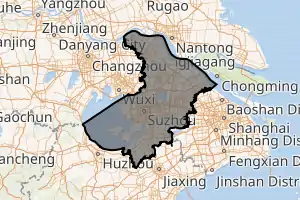 | |
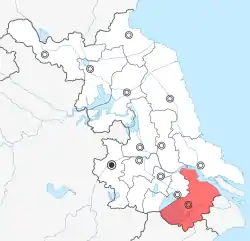 Location in Jiangsu | |
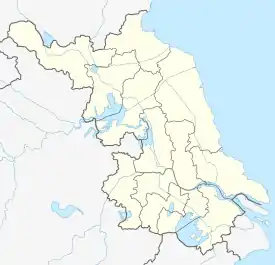 Suzhou Location of the city center in Jiangsu 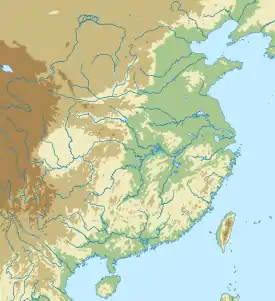 Suzhou Suzhou (Eastern China)  Suzhou Suzhou (China) | |
| Coordinates (Suzhou municipal government): 31°17′59″N 120°35′07″E | |
| Country | People's Republic of China |
| Province | Jiangsu |
| County-level divisions | 11 |
| Established | 514 BC |
| Municipal seat | Gusu District |
| Government | |
| • Type | Prefecture-level city |
| • Party Secretary | Lan Shaomin |
| • Mayor | Li Yaping |
| Area | |
| • Prefecture-level city | 8,488.42 km2 (3,277.40 sq mi) |
| • Land | 5,851 km2 (2,259 sq mi) |
| • Water | 2,394.50 km2 (924.52 sq mi) |
| • Urban | 2,944.4 km2 (1,136.8 sq mi) |
| • Metro | 12,493 km2 (4,824 sq mi) |
| Population (2020 census) | |
| • Prefecture-level city | 12,748,252 |
| • Density | 1,500/km2 (3,900/sq mi) |
| • Urban | 6,715,559 |
| • Urban density | 2,300/km2 (5,900/sq mi) |
| Demonym | Suzhounese |
| Time zone | UTC+8 (Beijing Time) |
| Postal code | 215000 |
| Area code | 512 |
| ISO 3166 code | CN-JS-05 |
| GDP (2021) [2] |
CNY 2.272 trillion
CNY 178,207
|
| HDI (2015) | 0.868– very high[3] |
| City flower | Osmanthus |
| City tree | Camphor laurel |
| Regional dialect | Wu: Suzhou dialect |
| License plate prefix | 苏E and 苏U[4] |
| Website | www |
| Suzhou | |||||||||||||||||||||||||||||||
|---|---|---|---|---|---|---|---|---|---|---|---|---|---|---|---|---|---|---|---|---|---|---|---|---|---|---|---|---|---|---|---|
.svg.png.webp) "Suzhou" in Simplified (top) and Traditional (bottom) Chinese characters | |||||||||||||||||||||||||||||||
| Simplified Chinese | 苏州 | ||||||||||||||||||||||||||||||
| Traditional Chinese | 蘇州 | ||||||||||||||||||||||||||||||
| |||||||||||||||||||||||||||||||
Founded in 514 BC, Suzhou has had a long and productive history. Local museums host abundant displays of its relics and many sites of historical interest exist. Around AD 100, during the Eastern Han Dynasty, it became one of the ten largest cities in the world, mostly due to emigration from northern China.[8][9] Since the 10th century, Suzhou has been an important center of China's industry and foreign trade. During the late 15th century to the 19th century, Suzhou was a national economic, cultural, and commercial center,[10] as well as the largest non-capital city in the world, until it was overtaken by Shanghai.[11][12] Since major economic reforms began in 1978, Suzhou has become one of the fastest growing major cities in the world, with GDP growth rates of about 14% in the past 35 years.[13][14] With high life expectancy and per capita incomes, Suzhou's Human Development Index ratings is roughly comparable to a moderately developed country, making it one of the most highly developed and prosperous cities in China.[3]
Suzhou is also famous for its classical gardens, date back to the 6th century BC, when the city was founded as the capital of the state of Wu. Inspired by these royal hunting gardens built by the King of Wu, private gardens began emerging around the 4th century and finally reached the climax in the 18th century.
Suzhou is also one of the top 50 major cities in the world by scientific research outputs as tracked by the Nature Index,[15] and home to multiple major universities in China, including Soochow University, Suzhou University of Science and Technology, Xi'an Jiaotong-Liverpool University and Changshu Institute of Technology.[16][17]
The city's canals, stone bridges, pagodas, and meticulously designed gardens have contributed to its status as one of the top tourist attractions and liveable cities in China. The Classical Gardens of Suzhou were added to the list of the UNESCO World Heritage Sites in 1997 and 2000. Suzhou is often dubbed the "Venice of the East" or "Venice of China".[18][19][20]
Names
During the Zhou Dynasty, a settlement known as Gusu after nearby Mount Gusu (simplified Chinese: 姑苏山; traditional Chinese: 姑蘇山; pinyin: Gūsūshān) became the capital of the state of Wu. From this role, it also came to be called Wu as well. In 514 BC, King Helü of Wu established a new capital nearby at Helü City and this grew into the modern city. During the Warring States period, Helü City continued to serve as the local seat of government. From the areas it administered, it became known as Wuxian (lit. "Wu County") and Wujun ("Wu Commandery").[21] Under the Qin, it was known as Kuaiji after its greatly enlarged commandery, which was named for the reputed resting place of Yu the Great near modern Shaoxing in Zhejiang.
The name "Suzhou" was first officially used for the city in AD 589 during the Sui dynasty. Su (蘇 or 苏) in its name is a contraction of the old name Gusu. It refers to the mint perilla (shiso). The zhou 州 originally meant something like a province or county (cf. Guizhou), but often came to be used metonymously for the capital of such a region (cf. Guangzhou, Hangzhou, etc.).[22] Suzhou is the Hanyu Pinyin spelling of the Putonghua pronunciation of the name. Prior to the adoption of pinyin, it was variously romanized as Soo-chow, Suchow, or Su-chow.[23][24]
History
Suzhou, the cradle of Wu culture,[25][26] is one of the oldest towns in the Yangtze Basin. By the Spring and Autumn period of the Zhou, local Baiyue tribes named the Gou Wu are recorded living in the area which would become the modern city of Suzhou. These tribes formed villages on the edges of the hills above the wetlands surrounding Lake Tai.
Sima Qian's Records of the Grand Historian records traditional accounts that the Zhou lord Taibo established the state of Wu at nearby Wuxi during the 11th century BC, civilizing the local people and improving their agriculture and mastery of irrigation. The Wu court later moved to Gusu within the area of modern Suzhou. In 514 BC,[27] King Helü of Wu relocated his court nearby and called the settlement Helü City after himself. His minister Wu Zixu was closely involved with its planning and it was this site that grew into present-day Suzhou. The height of his tower on Gusu Hill (Gusutai) passed into Chinese legend. In 496 BC, King Helü was buried at Tiger Hill. In 473 BC, Wu was defeated and annexed by Yue, a kingdom to its southeast; Yue was annexed in turn by Chu in 306 BC. Remnants of the ancient kingdom include pieces of its 2,500-year-old city wall and the gate through it at Pan Gate.
The city was originally laid out according to a symbolic three-by-three grid of nine squares, with the royal palace occupying the central position.[28]
During the Warring States period, Suzhou was the seat of Wu County and Commandery. Following the Qin Empire's conquest of the area in 222 BC, it was made the capital of Kuaiji Commandery, including lands stretching from the south bank of the Yangtze to the unconquered interior of Minyue in southern Zhejiang. Amid the collapse of the Qin, Kuaiji's governor Yin Tong attempted to organize his own rebellion only to be betrayed and executed by Xiang Liang and his nephew Xiang Yu, who launched their own rebellion from the city.
When the Grand Canal was completed, Suzhou found itself strategically located on a major trade route.[23] Suzhou served as the regional metropolis of industry and foreign commerce on the southeastern coast of China. During the Tang dynasty, the great poet Bai Juyi constructed the Shantang Canal (better known as "Shantang Street") to connect the city with Tiger Hill for tourists. In AD 1035, the Suzhou Confucian Temple was founded by famed poet and writer Fan Zhongyan. It became a venue for the imperial civil examinations and then developed into the modern Suzhou High School in the 1910s.
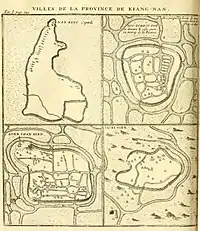
After February 1130, riots and unrest disrupted Suzhou.[29] In 1356, Suzhou became the capital of Zhang Shicheng, King of Wu. In 1367, Zhang's rival Zhu Yuanzhang took the city after a 10-month siege. Zhu – who was soon to proclaim himself the first emperor of the Ming Dynasty – demolished the old city walls at the center of Suzhou's walled city and imposed crushing taxes on the city and prefecture's powerful families.[30] Despite the heavy taxation and the forced exile of some prominent citizens' south, Suzhou was soon prosperous again. During the early Ming, Suzhou Prefecture supervised the Yangtze shoals which later became Shanghai's Chongming Island.[31] For centuries the city, with its surroundings as an economic base, represented an extraordinary source of tax revenue.[32]
When the shipwrecked Korean official Choe Bu had a chance to see much of Eastern China from Zhejiang to Liaoning on his way home in 1488, he described Suzhou in his travel report as exceeding every other city.[33] Many of the area's private gardens were constructed by the imperial gentry. The Taipings captured the city in 1860, however, and many of its former buildings and gardens were "almost... a heap of ruins"[23] by the time of their recovery by Charles Gordon's Ever-Victorious Army in November 1863.[24] Nonetheless, by 1880, its population was estimated to have recovered to about 500,000,[23] which remained stable for the next few decades.[24] In the late 19th century, the town was particularly known for its wide range of silks and its Chinese-language publishing industry.[23] The town was first opened to direct foreign trades by the Treaty of Shimonoseki ending the First Sino-Japanese War[24] and by the most favored nation clauses of earlier unequal treaties with the Great Powers. The new expatriates opened a European-and-Chinese school in 1900 and the Suzhou railway station, connecting it with Shanghai, opened[24] on 16 July 1906. Just prior to the World War I, there were 7000 silk looms in operation, as well as a cotton mill and a large trade in rice.[24]
As late as the early 20th century, much of the city consisted of islands connected by rivers, creeks, and canals to the surrounding countryside.[24] Prior to their demolition, the city walls ran in a circuit of about 10 miles (16 km) with four large suburbs lying outside.[24] The Japanese invaded in 1937, and many gardens were again devastated by the end of the war. In the early 1950s, restoration was done on the Humble Administrator's Garden and the Lingering Garden.
Administrative divisions
The urban core of Suzhou is informally called the "Old Town." It is Gusu District. Suzhou Industrial Park is to the east of the old town, and Suzhou High & New Technology Development Zone is to the west. In 2000, the original Wu County was divided into two districts including Xiangcheng and Wuzhong. They now form the northern and southern parts of the city of Suzhou. In 2012, the original Wujiang City became Wujiang District of Suzhou City.
Suzhou is one of the most prosperous cities in China. Its development has a direct correlation with the growth of its satellite cities, including Kunshan, Taicang, Changshu, and Zhangjiagang, which together with the city of Suzhou form the Suzhou prefecture. The Suzhou prefecture is home to many high-tech enterprises.
| Map | |||||
|---|---|---|---|---|---|
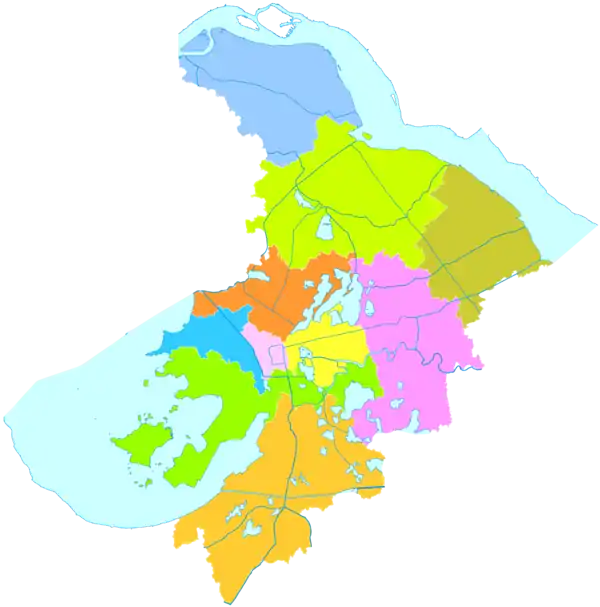
Huqiu
Wuzhong
Xiangcheng
Gusu
Wujiang
Changshu
(city) Zhangjiagang
(city) Kunshan
(city) Taicang
(city) Suzhou
Industrial Park Lake Tai
| |||||
| Subdivision | Simplified Chinese | Hanyu Pinyin | Population (2020)[34] | Area (km2) | Density (/km2) |
| City Proper | |||||
| Gusu District | 姑苏区 | Gūsū Qū | 2,058,010 | 372 | 5,532.28 |
| Suburban | |||||
| Huqiu District | 虎丘区 | Hǔqiū Qū | 832,499 | 258 | 3,226.74 |
| Wuzhong District | 吴中区 | Wúzhōng Qū | 1,388,972 | 672 | 2,066.92 |
| Xiangcheng District | 相城区 | Xiāngchéng Qū | 891,055 | 416 | 2,141.95 |
| Wujiang District | 吴江区 | Wújiāng Qū | 1,545,023 | 1,093 | 1,413.56 |
| Satellite cities (County-level cities) | |||||
| Changshu City | 常熟市 | Chángshú Shì | 1,677,050 | 1,094 | 1,532.95 |
| Taicang City | 太仓市 | Tàicāng Shì | 831,113 | 620 | 1,340.50 |
| Kunshan City | 昆山市 | Kūnshān Shì | 2,092,496 | 865 | 2,419.07 |
| Zhangjiagang City | 张家港市 | Zhāngjiāgǎng Shì | 1,432,044 | 772 | 1,854.97 |
| Total | 12,748,252 | 8,488 | 1,501.84 | ||
| Not formal administrative subdivisions – Suzhou Industrial Park & Suzhou New District Defunct districts – Canglang District, Pingjiang District, & Jinchang District | |||||
Geography
Suzhou is on the Lake Tai Plain south of the Yangtze River, about 100 km (60 mi) to the west of Shanghai and just over 200 km (120 mi) east of Nanjing.
Climate
Suzhou has a four-season humid subtropical climate with hot, humid summers and cool, cloudy, damp winters with occasional snowfall (Köppen climate classification Cfa). Northwesterly winds blowing from Siberia during winter can cause temperatures to fall below freezing at night, while southerly or southwesterly winds during the summer can push temperatures above 35 °C (95 °F). The hottest temperature recorded since 1951 was at 41.0 °C (106 °F) on 7 August 2013,[35][36] and the lowest at −9.8 °C (14 °F) on 16 January 1958.[37]
| Climate data for Suzhou(Pingjiang), (normals 1981–2010, extremes 1951–2007) | |||||||||||||
|---|---|---|---|---|---|---|---|---|---|---|---|---|---|
| Month | Jan | Feb | Mar | Apr | May | Jun | Jul | Aug | Sep | Oct | Nov | Dec | Year |
| Record high °C (°F) | 21.3 (70.3) |
27.4 (81.3) |
30.4 (86.7) |
34.6 (94.3) |
36.3 (97.3) |
37.5 (99.5) |
39.3 (102.7) |
39.7 (103.5) |
37.4 (99.3) |
33.1 (91.6) |
28.2 (82.8) |
22.8 (73.0) |
39.7 (103.5) |
| Average high °C (°F) | 8.0 (46.4) |
10.5 (50.9) |
14.9 (58.8) |
20.6 (69.1) |
25.9 (78.6) |
28.8 (83.8) |
32.8 (91.0) |
32.3 (90.1) |
28.5 (83.3) |
23.5 (74.3) |
17.2 (63.0) |
11.0 (51.8) |
21.2 (70.1) |
| Daily mean °C (°F) | 4.4 (39.9) |
6.4 (43.5) |
10.4 (50.7) |
15.9 (60.6) |
21.2 (70.2) |
24.9 (76.8) |
28.8 (83.8) |
28.5 (83.3) |
24.7 (76.5) |
19.5 (67.1) |
13.0 (55.4) |
7.0 (44.6) |
17.1 (62.7) |
| Average low °C (°F) | 1.5 (34.7) |
3.4 (38.1) |
7.0 (44.6) |
12.2 (54.0) |
17.5 (63.5) |
21.9 (71.4) |
26.0 (78.8) |
25.8 (78.4) |
21.9 (71.4) |
16.3 (61.3) |
9.8 (49.6) |
4.0 (39.2) |
13.9 (57.1) |
| Record low °C (°F) | −9.8 (14.4) |
−6.6 (20.1) |
−3.7 (25.3) |
−0.5 (31.1) |
7.3 (45.1) |
13.3 (55.9) |
18.4 (65.1) |
18.6 (65.5) |
11.7 (53.1) |
2.8 (37.0) |
−2.2 (28.0) |
−7.7 (18.1) |
−9.8 (14.4) |
| Average precipitation mm (inches) | 77.8 (3.06) |
72.5 (2.85) |
104.0 (4.09) |
83.9 (3.30) |
119.7 (4.71) |
206.4 (8.13) |
153.0 (6.02) |
172.3 (6.78) |
78.9 (3.11) |
58.2 (2.29) |
63.2 (2.49) |
48.5 (1.91) |
1,238.4 (48.74) |
| Average precipitation days (≥ 0.1 mm) | 11.7 | 11.1 | 13.4 | 12.9 | 12.0 | 14.2 | 10.5 | 12.7 | 11.0 | 8.4 | 8.1 | 9.2 | 135.2 |
| Average relative humidity (%) | 77 | 78 | 76 | 75 | 75 | 77 | 71 | 72 | 74 | 73 | 75 | 75 | 75 |
| Mean monthly sunshine hours | 108.4 | 104.2 | 122.5 | 144.9 | 164.4 | 146.9 | 209.7 | 208.0 | 170.8 | 159.5 | 126.8 | 122.3 | 1,788.4 |
| Source: Suzhou Almanac[38] | |||||||||||||
Cityscape and environment
 Suzhou as viewed from Beisi Pagoda
Suzhou as viewed from Beisi Pagoda Pingjiang Road
Pingjiang Road Changmen at night
Changmen at night The Humble Administrator's Garden
The Humble Administrator's Garden An entrance to the Youyicun Garden
An entrance to the Youyicun Garden%252C_Suzhou.jpg.webp) Xuanmiao Temple
Xuanmiao Temple A canal in Suzhou
A canal in Suzhou Picture of the Land and Water Gate
Picture of the Land and Water Gate View of Panmen Scenic Area and Ruiguang Pagoda
View of Panmen Scenic Area and Ruiguang Pagoda
Classical Gardens of Suzhou
Suzhou is famous for its over 60 Classical Gardens, collectively a UNESCO World Heritage Site. The city has the most UNESCO-recognized gardens in the world.[39]
The Humble Administrator's Garden and Lingering Garden are among the four most famous classical gardens in China. The Canglang Pavilion, Lion Grove Garden, Humble Administrator's Garden and Lingering Garden, respectively representing the garden styles of traditional architecture are called the four most famous gardens in Suzhou. Other gardens inscribed on the World Heritage List include the Couple's Retreat Garden, the Garden of Cultivation, and the Retreat and Reflection Garden.
Temples
- Hanshan Temple
- Xiyuan Temple
- Xuanmiao Temple
- Lingyanshan Temple
- Chongyuan Temple
Canals and Historic Districts

The Suzhou section of the Jiangnan Canal, Grand Canal (China), includes ten city gates and over 20 stone bridges of traditional design and historic areas that have been well preserved, as well as temples and pavilions. [40][41] [42] There are a full 24 waterways in Suzhou near the Grand Canal.[43]
In 2015, both 800-year-old Pingjiang Road Historical Block (平江路) and 1,200-year-old Shantang Street Scenic Area (山塘街) were added to the list of China's "National Historic and Cultural Streets".[44][45]
Pingjiang Road runs parallel to the Pingjiang River for 1.5 kilometers and is lined with homes and some teahouses. Shantang Street, over twice as long at 3.8 km, is described by the BBC as retaining "the alluring qualities of an old canal-side street: whitewashed buildings are completed by red-tasseled lanterns that swing softly in the breeze, adding to the charm of the river bank".[43]

Boat tours are offered on the waterways of this city that was dubbed the "Venice of the East" by Marco Polo because of its criss-crossing canals and stone bridges.[46][47] The Grand Canal (from Beijing to Zhejiang province) is a UNESCO World Heritage Site.
Resorts and natural reserves
Suzhou Taihu National Tourism and Vacation Zone (苏州太湖国家旅游度假区) is in the western part of Suzhou, 15 km (9 mi) from the city center.[48][49]
Skyscrapers
Gate to the East is a 301.8 meter, 74-story skyscraper in Suzhou's central business district, built in 2015 at a cost of 700 million USD and is currently the tallest building in Suzhou.[50]
Pan Gate
Pan Gate is on the southwest corner of the Main Canal or encircling canal of Suzhou. Originally built during the Warring States Period in the state of Wu, historians estimate it to be around 2,500 years old. It is now part of the Pan Gate Scenic Area. It is known for the "three landmarks of Pan Gate". They are the Ruiguang Pagoda, the earliest pagoda in Suzhou built in 247 BC, the Wu Gate Bridge, the entrance to the gate at that time over the water passage and the highest bridge in Suzhou at the time, and the Pan Gate. The Ruigang Pagoda is constructed of brick with wooden platforms and has Buddhist carvings at its base.
Baodai Bridge
Baodai Bridge stretches across the Tantai Lake in the suburbs of Suzhou. To raise money to finance the bridge, the magistrate donated his expensive belt, hence the name. The bridge was first built in 806 A.D. in the Tang Dynasty and has 53 arches with a length of 317 meters. It was made out of stone from Jinshan Mountain and is the longest standing bridge of its kind in China. The bridge was included on the list of national monuments (resolution 5-285) in 2001.
Tiger Hill
Tiger Hill is known for its natural environment and historical sites. The hill is so named because it is said to look like a crouching tiger. Another legend states that a white tiger appeared on the hill to guard it following the burial The hill has been a tourist destination for hundreds, if not thousands, of years, as is evident from the poetry and calligraphy carved into rocks on the hill. The Song Dynasty poet, Su Shi said, "It is a lifelong pity if having visited Suzhou you did not visit Tiger Hill."
Pagodas
Yunyan Pagoda (or Huqiu Tower), built in 961, is a Chinese pagoda built on Tiger Hill in Suzhou. It has several other names, including the "Leaning Tower of China" (as referred to by historian O.G. Ingles)[51] and the Yunyan Temple Tower. The tower rises to a height of 47 m (154 ft). It is a seven-story octagonal building built with blue bricks. In more than a thousand years the tower has gradually slanted due to forces of nature. Now the top and bottom of the tower vary by 2.32 meters. The entire structure weighs some 7,000,000 kilograms (15,000,000 lb), supported by internal brick columns.[52] However, the tower leans roughly 3 degrees due to the cracking of two supporting columns.[52]
Beisi Pagoda or North Temple Pagoda is a Chinese pagoda at Bao'en Temple in Suzhou. It rises nine stories in a height of 76 m (249 ft). It is the tallest Chinese pagoda south of the Yangtze river.
Twin Pagodas (simplified Chinese: 苏州双塔; traditional Chinese: 蘇州雙塔) lie in the Dinghui Temple Lane in the southeastern corner of the city proper of Suzhou. They are artistic and natural as they are close at hand. One of them is called "Clarity-Dispensing Pagoda," and the other, the "Beneficence Pagoda"; they are in the same form of architecture. There are many legends about this one-thousand-year-old pagodas. It is charming that the exquisite and straight Twin Pagoda look like two inserted writing brushes. There was originally a single-story house with three rooms just like a writing brush holder with the shadows of the two pagodas reclining on its roof at sunset. To the east of the pagoda is a square five-story bell building built in the Ming Dynasty which appears exactly like a thick ink stick. So there is a saying that "the Twin Pagodas are as writing brushes while the bell building as ink stick".
Museums
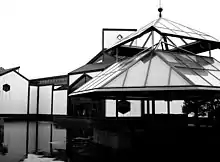
The city's major museums include the Suzhou Museum (designed by I. M. Pei), Suzhou Silk Museum, and the China Kunqu Museum.
Hospitals
As a result of its recent rapid population increase, healthcare demand in Suzhou is increasing rapidly. In July 2019, Washington University School of Medicine announced a collaboration with Huici Health Management Co., and the Xiangcheng District, to open the new Huici Medical Center, which will include a 1,000-bed hospital for adult and pediatric patients. Once the hospital is unveiled, Washington University doctors in St. Louis will be able to provide long-distance health-care services to patients in China through a telemedicine program.[53][54]
Demographics
The population of Suzhou is predominantly Han Chinese. The official language of broadcast, instruction, etc. is Mandarin Chinese, although many speak a local dialect known as Suzhounese, a member of the Wu language family. In addition to American and European expatriates, there is a large Korean community in Suzhou. The Industrial Bank of Korea (IBK) estimated that there were 15,000 Koreans in the municipality in 2014. That year 850 Korean companies operated in Suzhou, and the Koreans made up the largest number of students at the Suzhou Singapore International School.[55]
| Region | Total population 总户籍人口 (persons) |
Resident population 常住人口 (10,000 persons) |
|---|---|---|
| Whole municipality | 6 670 124 | 1061.60 |
| Urban area | 3 412 564 | 549.21 |
| Gusu District | 734 362 | 95.20 |
| Wuzhong District | 631 602 | 112.12 |
| Xiangcheng District | 405 400 | 72.87 |
| New & Hi-tech Zone, Huqiu District | 363 713 | 59.08 |
| Industrial Park | 459 535 | 80.26 |
| Wujiang District | 817 952 | 126.68 |
| County-level cities | 3 257 560 | – |
| Changshu | 1 068 211 | 151.01 |
| Zhangjiagang | 922 757 | 125.31 |
| Kunshan | 787 031 | 165.12 |
| Taicang | 479 561 | 70.95 |
Economy
Suzhou's economy is based primarily on its large manufacturing sector—China's first largest(from 2020)—including iron and steel, IT and electronic equipment, and textile products. The city's service sector is notably well-developed, primarily owing to tourism, which brought in a total of RMB 152 billion of revenue in 2013. Suzhou's overall GDP exceeded RMB 1.3 trillion in 2013 (up 9.6 percent from the year previous).[57]
The city is also one of China's foremost destinations for foreign investment, based on its relative proximity to Shanghai and comparatively low operating costs. The municipal government has enacted various measures to encourage FDI in a number of manufacturing (e.g. pharmaceutical, electronic goods, automobile) and service (e.g. banking, logistics, research services) sectors. Included among these measures is a preferential tax policy for limited partnership venture capital enterprises in the Suzhou Industrial Park.[57]
Suzhou is a highly developed economic region in China and is the economic centre, industrial, commercial and logistical hub city of Jiangsu province, as well as an important financial, cultural, artistic, educational and transportation centre.
Agriculture
In 2013, total grain production reached 1,311,200 tonnes, a decrease of 2.9%. Grain supply was effectively guaranteed through the vigorous construction of commodity grain production bases, wholesale grain markets and reserve systems.
Traditional handicrafts
Suzhou has a long history of reeling silkworms and has always been an important base for silk production in China. Since the Song and Yuan dynasties, Suzhou has been one of the centres of silk weaving and dyeing in the country, and in the Ming dynasty, the area around Suzhou, Song was the scene of the "clothing of the world".[58]
Development zones
_-_West_Bank_of_Jin_Ji_Lake.jpg.webp)
Suzhou Industrial Park
The Suzhou Industrial Park (SIP) is the largest cooperative project between the Chinese and the Singaporean government. It is beside Jinji Lake, which lies to the east of the Suzhou Old City. On 26 February 1994, Vice Premier Li Lanqing and Senior Minister Lee Kuan Yew represented China and Singapore respectively in signing the Agreement to jointly develop Suzhou Industrial Park (originally called the Singapore Industrial Park). The project officially commenced on 12 May in the same year. SIP has a jurisdiction area of 288 km2 (111 sq mi), of which, the China-Singapore cooperation area covers 80 km2 (31 sq mi) with a planned residential population of 1.2 million.[59]
SIP is home to the Suzhou Dushu Lake Science and Education Innovation District, an area of universities and higher education institutions, including Soochow University and Xi'an Jiaotong-Liverpool University. Suzhou Industrial Park is also a popular residential district for many foreigners who work and live in Suzhou, as well as 'new Suzhou' residents who migrated to the area in search of work opportunities.
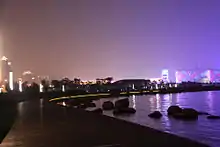
Suzhou Industrial Park Export Processing Zone
The Suzhou Industrial Park Export Processing Zone was approved to be established by the government in April 2000, with a planning area of 2.9 km2 (1.1 sq mi). It is in Suzhou Industrial Park set up by China and Singapore. Inside the Export Processing Zone, all the infrastructures are of high standard.[60]
Suzhou New District
The Suzhou New District was established in 1990. In November 1992, the zone was approved to be the national-level hi-tech industrial zone. By the end of 2007, foreign-invested companies had a registered capital worth of US$13 billion, of which US$6.8 billion was paid in. SND hosts now more than 1,500 foreign companies. Some 40 Fortune 500 companies set up 67 projects in the district.[61]
Sports
Suzhou Dongwu currently play in China League Two, the third division of Chinese football. The 13,000 seat Suzhou Industrial Park Sports Arena will be one of the venues for the 2019 FIBA Basketball World Cup.[62]
Transportation
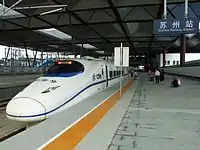
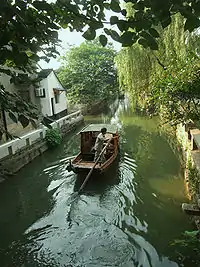
.JPG.webp)
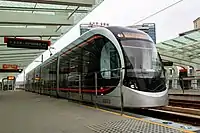
Railway
Suzhou is on the Shanghai-Nanjing corridor which carries three parallel railways. Suzhou railway station, near the city center, is among the busiest passenger stations in China. It is served by the Beijing–Shanghai railway (mostly "conventional" trains to stations throughout China) and the Shanghai-Nanjing intercity railway (high-speed D- and G-series trains providing frequent service primarily between Shanghai and Nanjing). It takes only 25 minutes to reach Shanghai railway station on the fastest G-series trains and less than 1 hour to Nanjing.
The Suzhou North railway station, a few kilometers to the north, is on the Beijing–Shanghai high-speed railway (opened 2011), served by high-speed trains to Beijing, Qingdao, etc.
Other stations on the Beijing–Shanghai railway and the Shanghai–Nanjing intercity railway serve other points in the same corridor within Suzhou Prefecture-level city, such as Kunshan. In between Suzhou and Kunshan South railway station, Suzhou Industrial Park railway station is also an important station for people visiting and living in the areas.
The northern part of the city, which includes Zhangjiagang, Changshu and Taicang, presently has no rail service. However, plans exist for a cross-Yangtze railway from Nantong to the Shanghai metropolitan area (the Shanghai–Nantong railway), which will run through most of these county-level cities. Construction work is expected to start in 2013 and to take five and a half years.[63]
Highways
The Nanjing-Shanghai Expressway connects Suzhou with Shanghai, alternatively, there is the Yangtze Riverine Expressway and the Suzhou-Jiaxing-Hangzhou Expressway. In 2005, the Suzhou Outer Ring was completed, linking the peripheral county-level cities of Taicang, Kunshan, and Changshu. China National Highway 312 also passes through Suzhou.
Air transport
Suzhou is served by three airports, Sunan Shuofang International Airport (co-owned by Wuxi and Suzhou), Shanghai Hongqiao International Airport (one hour drive), and Shanghai Pudong International Airport (two hours drive).[64]
Water transport
Port of Suzhou, on the right bank of the Yangtze River, dealt with 428 million tons of cargo and 5.86 million TEU containers in 2012, which made it the busiest inland river port in the world by annual cargo tonnage and container volume.[65][66]
Metro
The Suzhou Rail Transit currently has five lines in operation and five other lines under construction. The masterplan consists of nine independent lines. Line 1 started operation on 28 April 2012, Line 2 started operation on 28 December 2013,[67] and Line 4 started operation in 2017, Suzhou Railway Line 5 starts operation from June 2021. Line 6, Line 7 and Line 8 and Line S1 are under construction at the same time.
Tram
The Suzhou Tram system has two routes in the Suzhou New District.
Bus
Suzhou has public bus routes that run into all parts of the city. Fares are flat rated, usually 1 Yuan for a non-air-conditioned bus and 2 Yuan for an air-conditioned one. The Suzhou BRT, a 25-kilometer (16 mi)-long bus rapid transit system opened in 2008, operates 5 lines using elevated busways and bus-only lanes throughout the city.
Culture
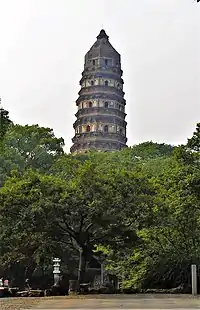
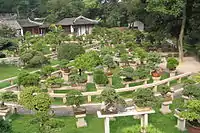
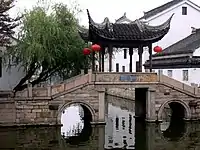
- Opera: Kunqu originated in the Suzhou region, as does the much later Suzhou Opera. Ballad-singing, or Suzhou pingtan, is a local form of storytelling that mixes singing (accompanied by the pipa and sanxian) with portions in spoken dialect.
- Silk: throughout China's Imperial past, Suzhou silk has been associated with high-quality silk products, supplying silks to ancient royal families. By the 13th century, Suzhou was already the center of the profitable silk trade.
- Song brocade: Suzhou's Song brocade, with its flashy colors, exquisite patterns, strong and soft texture, is one of China's three famous brocades, together with Nanjing Yun brocade and Sichuan Shu brocade. Suzhou's brocade production can be traced back to the Five Dynasties. It prospered in the Song Dynasty. After the government moved the capital southward, the country's political and cultural center moved to the Yangtze River area. To cope with the special need of artists, a type of very thin brocade for decorating paintings emerged in Suzhou. These brocades and paintings have been preserved. Whenever people talked about brocade, they mentioned the Song Dynasty, and thus Song brocade got its name and has been well-known ever since.
- Handicrafts: Suzhou embroidery, fans, Chinese musical instruments, scroll mounting, lanterns, mahogany furniture, jade carving, silk tapestry, traditional painting pigments of Jiangenxutang Studio, the New Year's wood-block prints of Taohuawu Studio.
- Paintings
- Calligraphic art
- Cuisine: Yangcheng Lake large crab
- Suzhou Silk Hand Embroidery Art
- Suzhou is the original place of "Jasmine", a song sung by Chinese singers or actresses thousands of times on the occasions of almost every important meetings or celebrations. Jasmine is the symbol of Suzhou as well as Tai Hu Lake.
- Suzhou Gardens: Gardens in Suzhou have an ancient history. The first garden in Suzhou belonged to the emperor of Wu State in Spring and Autumn Period (600 BC). More than 200 gardens existed in Suzhou between the 16th and 18th centuries. Gardens in Suzhou were built according to the style of Chinese Paintings. Every view in a garden can be seen as a piece of Chinese Painting and the whole garden is a huge piece of Chinese Paintings. At present, the Humble Administrator's Garden, built in 16th, is the largest private garden in Suzhou. It belonged to by Wang Xianchen, an imperial censor.
- Suzhou embroidery together with embroidery of Hunan, Sichuan and Guangdong are called as the "Four Famous Embroideries". Suzhou tapestry method is done in fine silks and gold thread. Other art forms found in this area are sculpture, Song brocade, jade and rosewood carving.
- The Suzhou Museum has a rich collection of relics from many eras. The collection includes revolutionary records, stele carving, folk customs, drama and verse, Suzhou embroidery, silk cloth, gardens, coins and Buddhist artifacts.[68]
- Wedding gowns[69]
Education
High schools
- Changshu High School
- Dulwich College Suzhou
- Dulwich International High School Suzhou
- Kunshan Senior High School
- SIP Experimental Middle School
- Suzhou Experimental High School
- Suzhou High School
- Suzhou Singapore International School
- Suzhou No.1 High School
- Suzhou No.10 High School
- Suzhou Wuxian High School (苏州吴县中学)
- Taicang Senior High School
- Zhenze Middle School
Universities and colleges
- Changshu Institute of Technology
- Duke Kunshan University
- KEDGE Business School
- Jiangnan Social University
- Jiangsu University Zhangjiagang Campus
- Renmin University of China Suzhou Campus
- Skema Business School – Chinese campus of the French business school
- Soochow University
- Suzhou Polytechnic Institute of Agriculture
- Suzhou University of Science and Technology
- Xi'an Jiaotong-Liverpool University
Under construction
- Nanjing University Suzhou Campus
- Northwestern Polytechnical University Taicang Campus
Postgraduate institutions
- Southeast University-Monash University Joint Graduate School
- Suzhou Dushu Lake Higher Education Town (National University of Singapore and Fudan Joint Graduate School, Nanjing University Graduate School, etc.)
Others
- Japanese School of Suzhou
- Overseas Chinese Academy Chiway Suzhou (苏州工业园区海归人才子女学校)[70]
See also
- List of twin towns and sister cities in China
- Port of Suzhou
Citations
- "Table showing land area and population". Suzhou People's Government. 2003. Archived from the original on 2 December 2007. Retrieved 7 September 2007.
- "2021年江苏13市Gdp出炉 苏州2.27万亿位居第一".
-
Calculated using data from Suzhou Statistics Bureau. Life Expectancy Index = 0.9672, Education Index = 0.8244, Income Index = 0.868. Refs:
- Suzhou Bureau of Statistics (苏州市统计局). 2016年苏州市情市力 (PDF). Archived (PDF) from the original on 14 March 2017. Retrieved 13 March 2017.
- 新建改扩建410所学校 苏州教育有"国际范". Tencent. Archived from the original on 14 March 2017. Retrieved 13 March 2017.
- 苏州人均期望寿命高于北京上海 癌症仍是"头号杀手". 城市商报. 22 April 2016. Archived from the original on 3 October 2017. Retrieved 5 October 2016.
- 苏U号牌来了!苏州将成江苏首个启用双号牌的城市. 交汇点. 24 October 2018. Archived from the original on 24 October 2018. Retrieved 24 October 2018.
- "Suzhou". Lexico UK English Dictionary. Oxford University Press. Archived from the original on 3 December 2020.
- United Nations, Department of Economic and Social Affairs, Population Division. "World Urbanization Prospects: The 2014 Revision" (PDF). Archived (PDF) from the original on 2 November 2014. Retrieved 1 January 2015.
{{cite web}}: CS1 maint: multiple names: authors list (link) - Elizabeth MacBride (22 December 2014). "Keep an eye on these emerging market cities". CNBC. Archived from the original on 1 January 2015. Retrieved 1 January 2015.
- Tertius Chandler (1987). Four Thousand Years of Urban Growth: An Historical Census. St. David's University Press. ISBN 978-0889462076.
- "Top 10 Cities of the Year 100". About.com. Archived from the original on 5 October 2013. Retrieved 20 October 2013.
- "The Grand Canal". UNESCO World Heritage Center. Archived from the original on 2 January 2014. Retrieved 1 January 2014.
- Xu (2000), pp. 16, 72–73, 159.
- Marme, Michael (2005). Suzhou: Where the Goods of All the Provinces Converge. Stanford: Stanford University Press. ISBN 9780804731126.
- Suzhou Bureau of Statistics. 2014年苏州市情市力 (PDF). Archived from the original (PDF) on 19 April 2014. Retrieved 19 April 2014.
- 寻梦苏州 探寻一座城市的现代化之路. 人民网. 26 January 2005. Archived from the original on 14 October 2013. Retrieved 27 August 2013.
- "Nature Index 2020 Science Cities | Supplements | Nature Index". www.natureindex.com. Retrieved 15 October 2020.
- "Nature Index 2018 Science Cities | Nature Index Supplements | Nature Index". www.natureindex.com. Retrieved 15 October 2020.
- "US News Best Global Universities Rankings in Suzhou". U.S. News & World Report. 26 October 2021. Retrieved 26 October 2021.
- Visit some of China's best gardens next week without a passport » Arts/Entertainment » Andover Townsman, Andover, MA. Andovertownsman.com. Retrieved 28 August 2011.
- Thorpe, Annabelle. "Suzhou: Real China outside Shanghai". The Times. London. Archived from the original on 4 June 2011. Retrieved 24 May 2010.
- Fussell, Betty (13 March 1988). "Exploring Twin Cities By Canal Boat". The New York Times. Archived from the original on 1 July 2017. Retrieved 24 May 2010.
- "Supplement to the Local Gazetteer of Wu Prefecture". World Digital Library. 1134. Archived from the original on 12 December 2013. Retrieved 6 September 2013.
- 中国古今地名大词典 [Dictionary of Chinese Place-names Ancient and Modern] (in Chinese (China)). Shanghai: Shanghai Lexicographical Publishing House. 2006. p. 1438.
- EB (1887).
- EB (1911).
- Suzhou Archived 6 October 2014 at the Wayback Machine, China Daily
- "Suzhou, Jiangsu, China". suzhou.jiangsu.net. Archived from the original on 23 April 2013. Retrieved 3 April 2013.
- The old editions of the Britannica give the erroneous date of AD 484.[23][24]
- Xu (2000), pp. 34–36.
- Hargett, James M. (1989). On the Road in Twelfth Century China: The Travel Diaries of Fan Chengda (1126–1193). Stuttgart: Steiner Verlag Wiesbaden. p. 73. ISBN 3-515-05375-1. OCLC 20650465.
- Johnson, Linda C. Cities of Jiangnan in Late Imperial China Archived 8 April 2019 at the Wayback Machine, pp. 26–27. SUNY Press, 1993. ISBN 0-7914-1423-X, 9780791414231.
- "Chongming County" in the Encyclopedia of Shanghai, pp. 50 ff. Archived 10 January 2015 at the Wayback Machine Shanghai Scientific & Technical Publishers (Shanghai), 2010. Hosted by the Municipality of Shanghai.
- Xu (2000), p. 16.
- Brook, Timothy. The Confusions of Pleasure: Commerce and Culture in Ming China. Berkeley: University of California Press, 1988. ISBN 0-520-22154-0. Page 45.
- "苏州市第七次全国人口普查公报(第二号) – 苏州市统计局". tjj.suzhou.gov.cn. Retrieved 21 January 2022.
- 41℃ 苏州在最热一天立秋. 中国江苏网. 8 August 2013. Archived from the original on 5 January 2016. Retrieved 5 November 2015.
- 昨最高气温再创历史新高 苏州筹划人工增雨降温. 城市商报 (in Chinese (China)). 1 August 2013. Archived from the original on 4 August 2013. Retrieved 20 January 2014 – via news.2500sz.com [Mingcheng News Online].
- 苏州历史最高最低气温问题 (in Chinese (China)). Suzhou People's Government. 20 January 2011. Archived from the original on 1 February 2014. Retrieved 20 January 2014.
- 国家气象科学数据中心. China Meteorological Data Service Center.
- "This City in China Has the Most Unesco-Recognized Gardens in the World". Archived from the original on 25 November 2018. Retrieved 24 November 2018.
- "The Grand Canal". Visit Our China. Archived from the original on 26 November 2018. Retrieved 26 November 2018.
- "Suzhou Grand Canal – Golden Waterway in China". China Discovery. Archived from the original on 26 November 2018. Retrieved 26 November 2018.
- Gang Xu (11 October 2013). Tourism and Local Development in China: Case Studies of Guilin, Suzhou and Beidaihe. p. 47. ISBN 9781136823404. Archived from the original on 26 November 2018. Retrieved 26 November 2018.
- "Suzhou: China's Canal Capital". BBC Travel. Archived from the original on 25 November 2018. Retrieved 24 November 2018.
- "Official Travel and Tourism Website for Suzhou". en.visitsz.com. Archived from the original on 26 June 2018. Retrieved 27 December 2018.
- "Historical streets in Jiangsu listed as national heritage". China Daily. Archived from the original on 26 November 2018. Retrieved 26 November 2018.
- "Suzhou --'Venice in the Orient'". China Internet Information Center. Archived from the original on 29 May 2017. Retrieved 24 November 2018.
- "A city called the 'Venice of the East'". Shanghai Daily. 30 June 2015. Archived from the original on 24 November 2018. Retrieved 24 November 2018.
- 苏州太湖旅游度假区顺利晋级5A级景区. Archived from the original on 15 September 2016. Retrieved 30 July 2016.
- 苏州太湖国家旅游度假区中心区控制性详细规划公示. Archived from the original on 12 June 2018. Retrieved 30 July 2016.
- "$700 million skyscraper 'resembles a pair of pants'". Archived from the original on 31 May 2016. Retrieved 30 July 2016.
- Ingles (1982), 144.
- Ingles (1982), 145.
- "Washington University to open medical center in China – Xinhua | English.news.cn". Xinhua News Agency. Archived from the original on 2 July 2019. Retrieved 29 February 2020.
- "School of Medicine forms collaboration with medical center in China". Washington University School of Medicine in St. Louis. 1 July 2019. Retrieved 29 February 2020.
- Kim, Hyung Min. "The Role of Foreign Firms in China's Urban Transformation: A Case Study of Suzhou" (Chapter 8). In: Wong, Tai-Chee, Sun Sheng Han, and Hongmei Zhang. Population Mobility, Urban Planning and Management in China. Springer Science+Business Media, 24 March 2015. ISBN 3319152572, 9783319152578. Start: 127 Archived 18 October 2015 at the Wayback Machine. CITED: p. 139 Archived 5 May 2016 at the Wayback Machine
- SuZhou Statistical Yearbook 2016 Archived 8 March 2018 at the Wayback Machine sztjj.gov.cn
- "China Regional Focus: Suzhou, Jiangsu Province" Archived 8 May 2014 at the Wayback Machine, China Briefing, Shanghai, 2 May 2014.
- zhu, xuanying (2018). "Innovative development of traditional handicrafts in Suzhou".
{{cite journal}}: Cite journal requires|journal=(help) - Rightsite.asi | Suzhou Industry Park Archived 25 March 2010 at the Wayback Machine. Rightsite.asia (26 February 1994). Retrieved 2011-08-28.
- Rightsite.asia | Suzhou Industrial Park Export Processing Zone
- Suzhou Hi-Tech Industrial Development Zone Archived 22 April 2010 at the Wayback Machine. Rightsite.asia. Retrieved 28 August 2011.
- The Official website of the 2019 FIBA Basketball World Cup Archived 27 May 2017 at the Wayback Machine, FIBA.com. Retrieved 9 March 2016.
- 沪通铁路2013年正式开建 南通到上海仅需一小时. huochepiao.com (in Chinese (China)). 24 December 2012. Archived from the original on 15 May 2013. Retrieved 25 December 2012.
- 苏州交通运输. People's Daily (in Simplified Chinese). Archived from the original on 30 September 2013. Retrieved 16 August 2013.
- 苏州港外贸吞吐量首破1亿吨. Xinhua Daily. 13 January 2013. Archived from the original on 17 October 2013. Retrieved 15 January 2013.
- 小汤. 苏州港去年货物吞吐量4.28亿吨. Suzhou Post. Archived from the original on 17 October 2013. Retrieved 24 March 2013.
- 苏州地铁规划图 (Suzhou MRT Map) (in Simplified Chinese). 20 April 2009. Archived from the original on 30 April 2012. Retrieved 20 April 2009.
- "Suzhou Museum". Archived from the original on 28 April 2009.
- "Coronavirus dampens celebrations in China's wedding gown city". Reuters. 24 August 2020. Retrieved 27 August 2020.
- "Homepage – OCAC Suzhou – 苏州工业园区海归人才子女学校". OCAC Suzhou. Retrieved 16 March 2022.
Works cited
- Baynes, T. S.; Smith, W.R., eds. (1887), , Encyclopædia Britannica, vol. 22 (9th ed.), New York: Charles Scribner's Sons, p. 617.
- Chisholm, Hugh, ed. (1911), , Encyclopædia Britannica, vol. 26 (11th ed.), Cambridge University Press, p. 7.
- Xu, Yinong (2000). The Chinese City in Space and Time: The Development of Urban Form in Suzhou. Hawaii: University of Hawaii Press. ISBN 9780824820763.
General references
- Economic profile for Suzhou at HKTDC
External links
- Official Resource for English-speaking travelers
- Official website for Suzhou's municipal government
- Suzhou city guide with open directory (Jiangsu Network)
 Geographic data related to Suzhou at OpenStreetMap
Geographic data related to Suzhou at OpenStreetMap
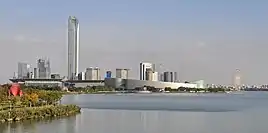








.png.webp)